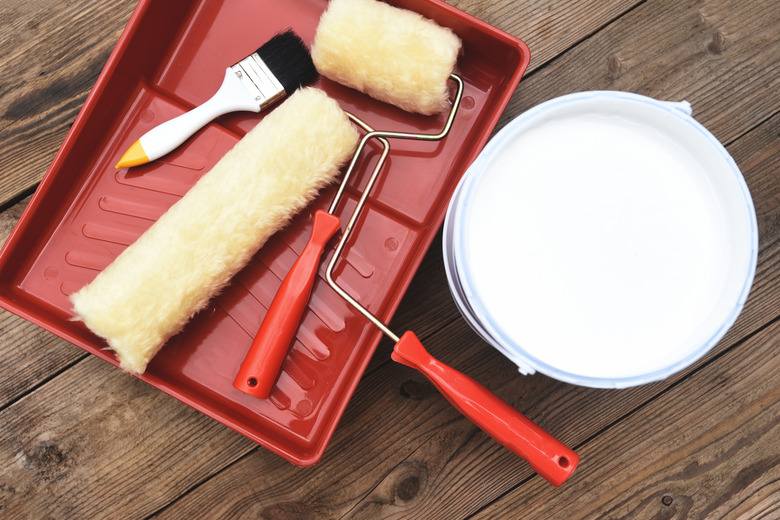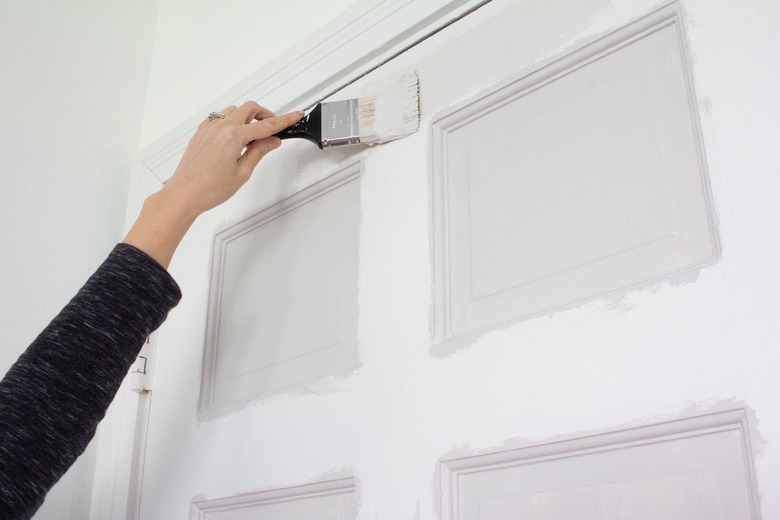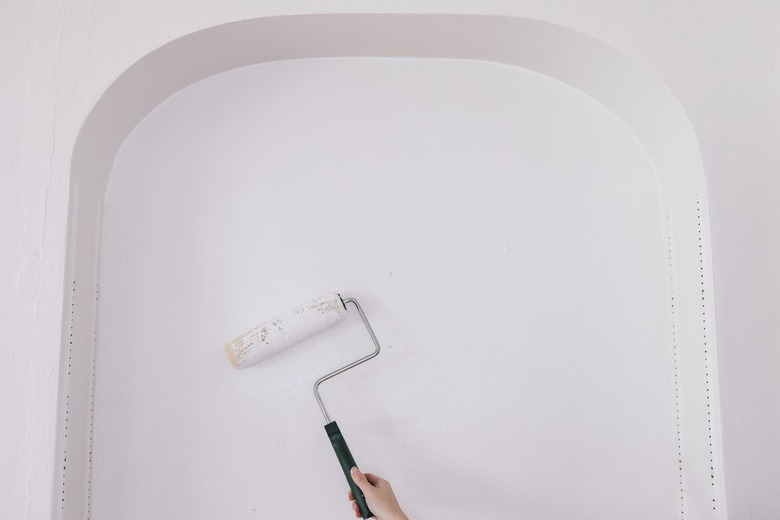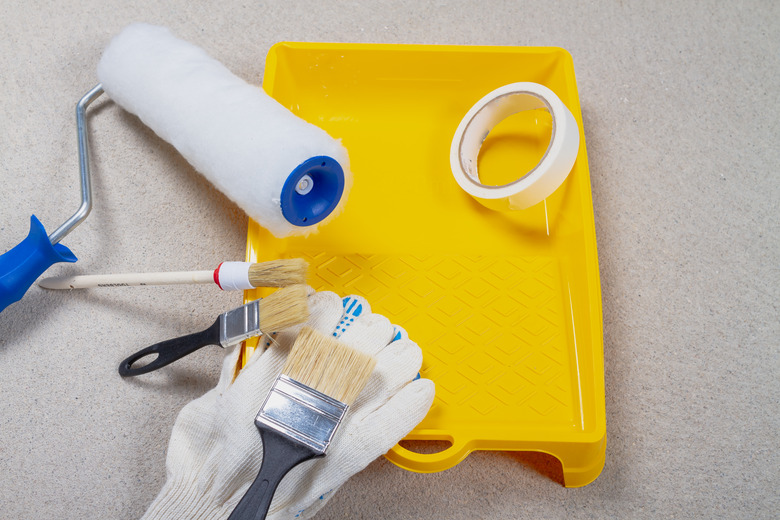A DIY Buyer's Guide To Paint Brushes, Rollers, And Roller Covers
Paintbrushes have been used for painting projects for millions of years, and they're still the ideal tool for many projects. But the paint roller, which was first patented in 1940, completely revolutionized painting. Although spray technology offers even easier ways to paint these days, most DIYers still reach for brushes and rollers when tackling a home painting project.
There are plenty of brushes and rollers to choose from when deciding what you need for your DIY, and it's important to choose wisely. The paintbrushes DIYers used before rollers were invented wouldn't be suitable for interior walls or woodwork in a contemporary home with latex paint, but there are paint jobs for which it would be perfect. By the same token, rollers designed for flat surfaces are inadequate for heavily textured walls, while rollers that work well on textured surfaces are overkill on flat ones. The right tool for your project ultimately depends on what you need it for.
How to Choose the Right Paintbrush
How to Choose the Right Paintbrush
Whether you're painting the walls and woodwork inside your house or outside, you'll need a paintbrush, perhaps more than one — even if you do most of the work with a roller. You can get by with inexpensive plastic brushes, but they don't always give the best results or last very long. You're far better off with quality brushes, and if you take care of them, they'll last for years.
Pay attention to these key elements when buying a paintbrush:
- Bristle material: Your choices are natural (which usually means some type of animal hair) and synthetic (nylon, polyester, or a combination of the two). Natural bristles are the originals; they hold a lot of paint and are still the best for oil paints. However, natural bristles are a poor choice for water-based or latex paint because the bristles soak up water and become floppy and difficult to control. Since most paint products these days are water-based, choose a synthetic-bristle brush if you're going to buy just one.
- Size: Putting aside artists' brushes (which are great for detail work), paintbrushes that you use for house painting range in width from 1 to 4 inches. Wide brushes pick up and hold more paint and reduce the number of strokes needed to cover a surface, but they are heavy and tiring to use. A paintbrush with a median width of 2 1/2 to 3 inches is best for all-purpose use.
- Angled vs. straight: Brushes with the ends of the bristles cut at an angle are known as sash brushes. Sash brushes are best for painting trim and woodwork and for cutting-in walls prior to rolling. Straight brushes, on the other hand, are best for flat, wide surfaces, like walls, fences, doors, and cabinets. They also do a better job on long, flat surfaces that have limited clearance, such as wide baseboards, or are difficult to reach, such as gutters.
- Handle length: Most brushes that house painters use have a handle that's roughly 6 inches in length. A longer handle provides more reach but reduces your ability to control the brush. Some trim brushes have stubby handles only a few inches long to maximize control when doing detail work.
If you prefer to limit your paintbrush collection to just the ones you need, you should have at bare minimum a 2 1/2-inch sash brush and a 4-inch straight brush. The Purdy 2 1/2-inch sash brush has synthetic bristles and an easy-grip wooden handle and can last for years with proper care. The Wooster Pro 4-inch flat brush also features an ergonomic hardwood handle, and a Wooster brush tends to spread paint more evenly and provides more control than other brushes, which is why Wooster is a popular brand with pros.
Tips for Choosing a Paint Roller
Tips for Choosing a Paint Roller
A paint roller is a slightly more complex tool than a paintbrush and consists of four main components:
- The paint roller frame is typically a length of heavy-gauge wire with a perpendicular bend, or hook, to accept the roller.
- The handle features a wooden or plastic grip and usually has a threaded opening at the end for an extension pole.
- The cage is a metal assembly that slides onto the perpendicular bend and spins on it.
- The cover is the component that slides onto the cage and holds and spreads the paint.
How to Choose the Right Size Paint Roller
Together, the lengths of the frame, cage, and cover determine the size of a roller, and sizes vary from 4 inches to 18 inches. The standard size of most rollers on the shelves of hardware stores is 9 inches, which is a good size for most jobs. But in certain situation, the size of your roller can make a huge difference.
Here's a list of common paint roller sizes and what projects they're ideal for:
- A 12- to 18-inch roller covers large walls, floors, and ceilings quickly and reduces painting time.
- A 6-inch mini roller works best for walls in spaces with limited clearance, such as bathrooms and kitchens.
- A 4-inch trim roller is best for baseboards, door and window casings, other interior moldings, and exterior trim.
The Right Roller Cover Material
Like paintbrush bristles, paint roller covers can be made of natural fibers, such as mohair or lamb's wool, or synthetic materials, like polyester and nylon. The general rule is to use natural fibers for oil-based paint and synthetic fibers for latex. Roller covers can also be made from foam or microfiber, both of which can be used with all types of paint and are best if you want a smooth, glossy finish that's free of lint.
Tip
One problem you might encounter with natural fibers that you won't encounter with synthetics is lint. Remove lint from a roller before you start painting by rolling it over a long strip of duct tape pulled taut.
The Proper Nap Length
The nap length, which refers to the length of the fibers on the roller cover, can vary from 3/16 inch to 3/4 inch. A roller with a short nap length, such as 3/16 or 1/4 inch, is best for smooth surfaces, like untextured drywall, because it uses less paint and spreads the paint more evenly. Medium-nap rollers (3/8 or 1/2 inch) are best for rough surfaces, like textured drywall or plywood. You need a long-nap roller cover (5/8 or 3/4 inches) for highly textured surfaces, like stucco and brick, to ensure paint gets into all the crevices in the surface.
|
Paint Roller Nap Length |
Ideal Painting Surface |
|
3/16 – 1/4 inches |
Untextured drywall and other smooth surfaces |
|
3/8 – 1/2 inches |
Rough surfaces, like textured drywall or plywood |
|
5/8 – 3/4 inches |
Highly textured surfaces, including stucco and brick |
Other Painting Supplies
Other Painting Supplies
When you paint with a brush and roller, you almost always need these tools as well:
- Painter's tape
- Canvas drop cloth
- Extension pole
- Paint tray
Use painter's tape to mask off areas, like trim, that you want to avoid getting paint on. A good-quality painter's tape, like Frog Tape, has low adhesion, so it won't pull paint off the surface you apply it to, yet it seals well at the edges to prevent paint seepage.
Paint splatters are inevitable when you use a roller, so it's important to spread drop cloths. A good-quality canvas drop cloth is your best bet because it absorbs paint splatters. This prevents you from walking on fresh paint and tracking it throughout the house. It also won't slip and slide like a plastic drop cloth and won't tear or bleed through easily like a paper one.
An extension pole allows you to reach high surfaces, such as ceilings, without having to move a ladder around the room, and it also helps you reach low areas, such as the bottom of walls, without bending over. Get a good-quality telescoping extension pole with a maximum reach of at least 12 feet for indoor painting. If you're painting outdoors, you may need a longer one with a reach of 24 feet to get the upper parts of walls and trim.
Paint trays are especially useful when using a roller. Once you pour some of your paint in the tray, you can easily dip your roller in to get an even wash of paint that's ready to be applied to the wall. Most paint trays have a textured portion so that you can run your roller along it to remove excess paint.



